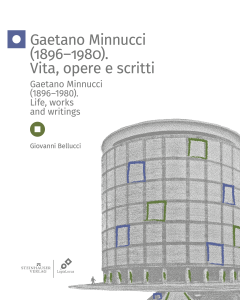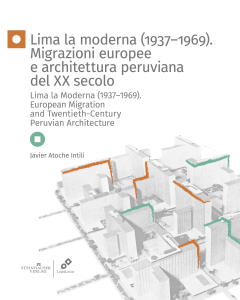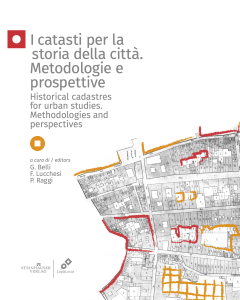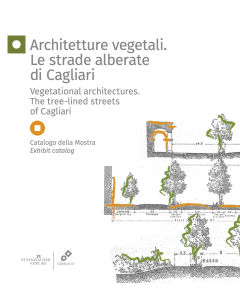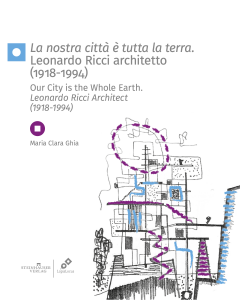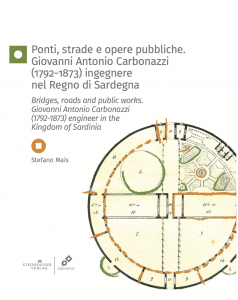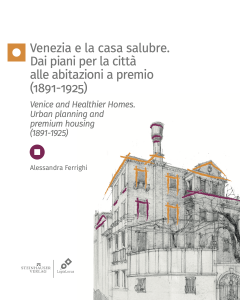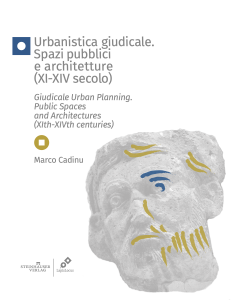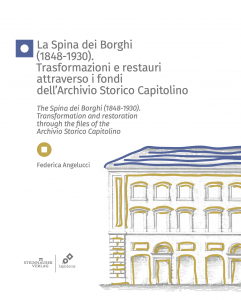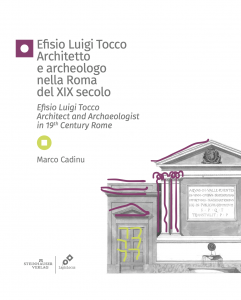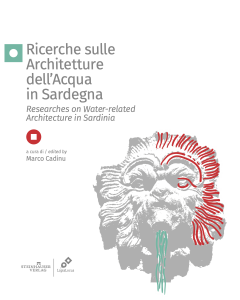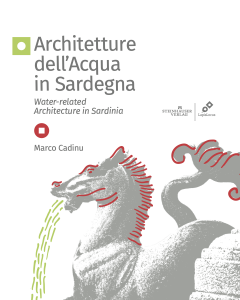2023
Giovanni Bellucci
Gaetano Minnucci (1896–1980). Vita, opere e scritti
Gaetano Minnucci (1896-1980). Life, works and writings
ISBN: 978-3-942687-59-1
2023
Javier Atoche Intili
Lima la moderna (1937-1969) Migrazioni europee e architettura peruviana del XX secolo
Lima la Moderna (1937-1969). European Migration and Twentieth-Century Peruvian Architecture
ISBN: 978-3-942687-58-4
2021
Gianluca Belli, Fabio Lucchesi, Paola Raggi (a cura di):
I catasti per la storia della città. Metodologie e prospettive
Historical cadastres for urban studies. Methodologies and perspectives
ISBN: 978-3-942687-54-6
2021
Marco Cadinu (a cura di):
Architetture vegetali. Le strade alberate di Cagliari. Catalogo della mostra
Vegetational architectures. The tree-lined streets of Cagliari. Exhibit catalog
ISBN: 978-3-942687-18-8
Le opere di arte e architettura legate all’uso dell’acqua sono riconosciute tra le più rilevanti categorie di beni culturali. Ma in genere solo a condizione che si tratti di opere dotate di un tenore artistico elevato o assegnate ad un maestro del passato, quindi solidamente presenti nell’immaginario collettivo e nella letteratura. In Sardegna – così come avviene in molte regioni italiane ed europee – solo poche decine corrispondono a questa immagine. Esistono invece migliaia di altre architetture dell’acqua, frutto di progettazioni e investimenti significativi, che offrono letture non meno utili sulle condizioni culturali e storiche di ciascun luogo. La loro considerazione in un sistematico quadro di lettura rimarca nuovi dettagli sulle stagioni dell’architettura, sulla diffusione delle soluzioni tipologiche e stilistiche, sull’aderenza o la distanza da modelli affermati nei grandi centri urbani.
2021
Maria Clara Ghia:
La nostra città è tutta la terra. Leonardo Ricci architetto (1918-1994)
Our City is the Whole Earth. Leonardo Ricci Architect (1918-1994)
ISBN: 978-3-924774-83-7
2020
Stefano Mais:
Ponti, strade e opere pubbliche. Giovanni Antonio Carbonazzi (1792-1873) ingegnere
nel Regno di Sardegna
Bridges, roads and public works. Giovanni Antonio Carbonazzi (1792-1873) engineer in the Kingdom of Sardinia
ISBN: 978-3-924774-79-0
2020
Alessandra Ferrighi:
Venezia e la casa salubre Dai piani per la città alle abitazioni a premio (1891-1925)
Venice and Healthier Homes. Urban planning and premium housing (1891-1925)
ISBN: 978-3-924774-82-0
2019
Marco Cadinu:
Urbanistica giudicale. Spazi pubblici e architetture (XI-XIV secolo)
Giudicale Urban Planning. Public Spaces and Architectures (XIth-XIVth centuries)
ISBN: 978-3-924774-71-4
History of Architecture, City and Landscape
The publisher Steinhäuser Verlag (Wuppertal, Germany – www.steinhaeuserverlag.de) has opened a new series of books dedicated to the History of Architecture. Each volume will be produced as a PDF for free download.
Steinhäuser Verlag has significant international visibility and has been operating since 1983 in the field of medicine and linguistics (340,000 scientific volumes downloaded over the last five years, about 3,000 users per week).
Since 2015, a new series has been dedicated to architectures.The volumes of the series in full color will largely employ graphics and images. The free PDF edition will ensure rapid and vast circulation with thousands of downloads. Manuscripts in English are preferred; manuscripts in other languages are expected to provide a substantial abstract, an index and introductions in English.
History of Architecture, City and Landscape
The publisher Steinhäuser Verlag (Wuppertal, Germany – www.steinhaeuserverlag.de) has opened a new series of books dedicated to the History of Architecture. Each volume will be produced as a PDF for free download.
Steinhäuser Verlag has significant international visibility and has been operating since 1983 in the field of medicine and linguistics (340,000 scientific volumes downloaded over the last five years, about 3,000 users per week).
Since 2015, a new series has been dedicated to architectures.The volumes of the series in full color will largely employ graphics and images. The free PDF edition will ensure rapid and vast circulation with thousands of downloads. Manuscripts in English are preferred; manuscripts in other languages are expected to provide a substantial abstract, an index and introductions in English.
2017
Federica Angelucci, La Spina dei Borghi (1848-1930). Trasformazioni e restauri attraverso i fondi dell’Archivio Storico Capitolino
The Spina dei Borghi (1848-1930). Transformation and restoration through the files of the Archivio Storico Capitolino
Steinhäuser Verlag, Wuppertal 2017
307 pages. Download the free PDF from the Academia website.
A critical analysis of the building and city planning applications submitted by property owners to the city authorities of Rome, has made it possible to obtain a detailed picture of the housing conditions in the Spina dei Borghi from 1848 to 1930.
The conditions of the buildings and their recognised roles are evinced from a careful reading of the partly unpublished documents found in the records of the Modern Papal Municipality [pre-unification Title 54 file (1848-1870)], of the post-unification Modern Municipality [post-unification Title 54 file (1871-1922)] and of Section V – Public Works – Building Inspectorate (1887-1930), conserved in the Archivio Storico Capitolino.
The aim is to shed light on the situation of the Spina’s buildings, highlighting an interesting modus operandi by property owners that continued almost until the Spina was destroyed under Mussolini.
2016
Marco Cadinu: Efisio Luigi Tocco. Architetto e archeologo nella Roma del XIX secolo
Efisio Luigi Tocco.Architect and Archaeologist in 19th Century Rome
Steinhäuser Verlag, Wuppertal 2016
308 pages. Download the free PDF from the Academia website.
Efisio Luigi Tocco was a civil architect scholar of archaeology and the protagonist of several excavations, as well as a Latinist. He spent his life between studies on ancient Roman architecture, pro jects and archaeological surveys, taking part in the cultural debate as shown by the significant number of published works. His activity over a period of fifty years allows us to understand many aspects of the culture and architecture of Italy before and immediately after its unification. Tocco, who came from Cagliari (1800 c. – 1874), lived and worked mainly in Rome and Lazio, maintaining close relationships with the cultural environments of the Kingdom of Sardinia, both in its island territories and in Liguria and Piedmont.
2015
Marco Cadinu (a cura di): Ricerche sulle Architetture dell’acqua in Sardegna
Researches on Water-related Architecture in Sardinia
Steinhäuser Verlag, Wuppertal 2015
332 pages. Download the free PDF from the Academia website.
Water architecture, apart from bearing witness to the art of building and the techniques used through history, bears significant immaterial value which strongly binds it to the history of its location. More than other work it is subject to degradation and re-building, more than others, it preserves the signs which connect us with the religion before the settlement, with the territory’s political planning and with the artistic or symbolic shapes which populations pass on from generation to generation.
In Sardinia, where the heritage of art and monuments comes to us only in a limited number of cases but where thousands of areas of water define a particularly rich territory -sometimes surprisingly so – the architectural heritage and historical evidence come to us through categories which are open to unusual kinds of interpretation: the correlation with medieval settlements, the strong sense of permanence of models and uses connected with the administration of the land, and building traditions deriving from an incessant alternation in the history of technical competences due to the confluence of the archaic mediterranean culture, the hispanic-muslim world, and finally with modernity. It is therefore a regional case study, but widely connected historically and geographically, so as to build a useful subject of comparison for studying architecture in other contexts.
2015
Marco Cadinu: Architetture dell’acqua in Sardegna
Water-related Architecture in Sardinia
Steinhäuser Verlag, Wuppertal 2015
342 pages. Download the free PDF from the Academia website.
Le architetture dell’acqua, oltre ad essere testimoni dell’arte del costruire e della tecnica adoperata nella storia, sono portatrici di notevoli valori immateriali e si legano alla storia dei luoghi con singolare tenacia. Più di altre opere sono soggette all’usura e alle ricostruzioni, più di altre conservano segni e contatti con la ragione prima dell’insediamento, con la programmazione politica del territorio, con le forme artistiche o simboliche che le popolazioni trasmettono di generazione in generazione. In Sardegna, dove l’investimento in chiave monumentale e artistico giunge a noi solo in un numero limitato di casi, ma dove molte migliaia di luoghi dell’acqua definiscono un territorio di particolare ricchezza – su questo piano a volte sorprendente – il patrimonio dell’architettura e la testimonianza storica emergono attraverso categorie che suggeriscono l’apertura di chiavi di lettura insolite: la relazione con l’insediamento medievale, il forte senso di permanenza di modelli e usi legati all’amministrazione dei luoghi, tradizioni costruttive frutto di un incessante alternarsi nella storia di competenze tecniche all’incrocio tra la cultura arcaica mediterranea, il mondo ispano-musulmano e quindi con le stagioni della modernità . Un caso studio regionale quindi ma correlato estesamente nella geografia e nella storia, tanto da costituire un utile materia di raffronto per lo studio delle architetture di ulteriori contesti.
Water architecture, apart from bearing witness to the art of building and the techniques used through history, bears significant immaterial value which strongly binds it to the history of its location. More than other work it is subject to degradation and re-building, more than others, it preserves the signs which connect us with the religion before the settlement, with the territory’s political planning and with the artistic or symbolic shapes which populations pass on from generation to generation.
In Sardinia, where the heritage of art and monuments comes to us only in a limited number of cases but where thousands of areas of water define a particularly rich territory -sometimes surprisingly so – the architectural heritage and historical evidence come to us through categories which are open to unusual kinds of interpretation: the correlation with medieval settlements, the strong sense of permanence of models and uses connected with the administration of the land, and building traditions deriving from an incessant alternation in the history of technical competences due to the confluence of the archaic mediterranean culture, the hispanic-muslim world, and finally with modernity. It is therefore a regional case study, but widely connected historically and geographically, so as to build a useful subject of comparison for studying architecture in other contexts.

